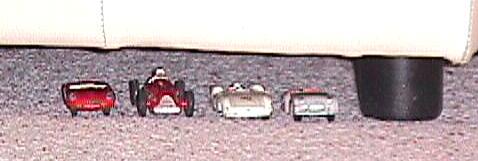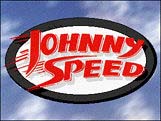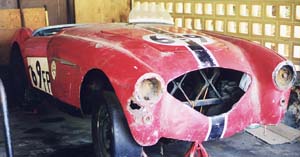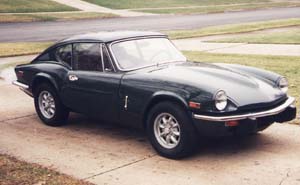British Car Week |

Many people have often wondered why I enjoy classic British machinery as much as I do, and they probably also wonder why I take the time to promote these special cars of the past. Here is a condensed story I have written to help explain. My story probably isn�t much different than many other British car enthusiasts who grew up during the 50�s and 60�s.....
My British car days began at a very young age during the early 1960's. During that period of time my tender little ears would frequently tune in to some of the many interesting stories my uncle would tell about his cars while my family was joined around the dining room table during family functions. He owned and drove some very interesting vehicles in his day, ranging from cars badged with the likes of MG, Austin-Healey, Triumph, Hillman Minx, Kaiser Darin, Karman Ghia, Chrysler, Studebaker Hawk, Mustang, and others. But it was the British cars that intrigued me the most.
At around that same time my parents used to buy me little cars as gifts. I ended up owning a sizable collection of small Dinky Toy cars, and would play with them endlessly. I owned a variety of these cars, and the majority of them were British cars, most likely because Dinkey Toys were manufactured in England. One of my favorites was a little gray Triumph long-door TR2 with red interior. Among some of my other favorites were a Jaguar XK120, Jaguar XKE, Jaguar MkII, MG, Rover, Bentley, English Ford, Astin Martin, Mini Cooper, Austin-Healey, and many others. At that time, I really didn't realize my affliction for British cars, but I must have known great styling when I saw it.
These little cars covered every square inch of my parents family room floor, a hundred times or more. An arm chair became my estate, and the area between the chair legs was the garage space. Of course I had a large collection of cars, so I needed a big place to store them. The sofa across the room became a high-rise shopping complex with many stores and offices. When I drove my cars to the store, I would park them in the parking garage underneath the sofa. Since I owned many cars, I would always choose the car that felt best for my mood on that particular day. I would drive one of the top down roadsters on sunny days, and a saloon or coupe on rainy or cold days. It didn't matter what the forecast was going to be, because I had a car for all occasions.
Once I realized I was too mature to be seen crawling around on my hands and knees playing with little cars, I graduated to a more sophisticated remote controlled Jaquar XKE. It was bright red, and they called it the Johnny Speed, named after an adventure hero by Ren� Brantonne. The Johnny Speed was a really cool 1:12 scale sports car that was battery operated, and could go forward or reverse. The front wheels would turn right or left to enable you to steer around an obstacle or avoid an accident with the family cat or dog. It had a remote control box that connected to the car by wire, and a handle that could be moved in whatever direction the driver wanted the car to go. Twisting the handle would cause the wheels to turn. It was state-of-the-art for its day, and I spent hours upon hours of enjoyment while playing with it until it finally broke.
  Next I joined the big boys with the slot cars. Just about every kid in the neighborhood owned a slot car track of some kind. Most popular in my neighborhood was the Aurora HO set. The cars were called Thunderjets, or HO cars. These little slot cars were about 2 � inches long, and would race around on a slotted track designed for two cars at a time. Our tracks typically had a little control box with a steering wheel that could be turned to control the speed of the car. If you were really good, you could control the car without rolling it or spinning out. Once we became more experienced, we learned how to work on the cars to make them go faster and handle better. We would install larger gummy tires for better grip, and learned other little tricks that would make the car perform better. At one time I had the fastest car, until I accidently left the car at a friends house. The next time I used the car, it was one of the slowest, and my "friends" car was now one of the fastest. As with my Dinkey Toy cars, my favorites were always the British cars, even though they were less common than the American cars such as Camaro's, GTO's, and Mustang's.
 By the time I was thirteen years old I had my own newspaper route, and was earnestly saving money to buy my first real car. It was around this period of time when my older sister had a boyfriend who started coming around the house while driving his yellow Triumph Spitfire. I can remember having a strong urge to catch a ride in it, but of course my sister wouldn't have anything to do with me trying to interfere with her important relations. So I quietly watched the yellow Spitfire come and go while catching a glimpse through the living room window. As luck would have it, just around this same period of time my other sister came home from college with her boyfriend. Girls must have liked guys with Spitfires, because this guy was driving a red Spitfire. He noticed right off the bat that I was very enthused with his car, and he offered me a ride. It was my very first ride in a British car, and it was as exciting as I knew it would be! It wasn't until my freshman year in high school that I gained enough independence to start a serious search for my first car. I had some older friends who already had their driver�s license, and just for fun we used to seek out British cars for sale, and then go take a look at them. Of course we weren�t necessarily looking to buy, but we just enjoyed looking at them because they were so interesting. I can remember some of the older cars would be parked next to or behind the owners house waiting for someone to come along and rescue them, and others were in very good shape. Whether they were road worthy or not didn�t matter to us, because we simply enjoyed looking at them, and we knew they could be restored to better than new condition due to their simple nature. You just never knew what neat car you might run across.

Then one day when I was fifteen years old, I learned about a green 1957 Triumph TR3 that was for sale by a friend�s older brother. I immediately made arrangements to go see the car, and this time I was serious to buy. Since I had not yet received my drivers license, I had to ride shotgun with the owner, but I could tell that it would be a fun car to drive. I can recall that it had some exterior rust bubbling underneath the paint work, and also had a quirky problem with one of the front disc brakes, but that didn�t matter to me because I knew it could be dealt with. Unfortunately, when presenting the idea to my Dad, he didn't share my same enthusiasm. He felt that I should buy an American car instead. As a result, my first car was a Ford Pinto. Little did my Dad know at the time, but American car manufacturers were having their problems too.
After college, marriage, house, kids, and a busy life in general, the years went by quickly. I ended up owning some pretty boring non-British cars, and learned my repair skills from these cars. Yes, they got me to and from where I needed to go, but the trip wasn�t anything more than dull. Then one day out of the blue, an old out of town friend happened to come by for a visit. While we were sitting on the back patio enjoying some refreshments and discussing some of the old times that we had together, he told me about a very nice Triumph GT6 that another friend had for sale in St. Charles, Missouri. He said that it was very well preserved, but needed some tender loving care to get it back on the road again. We talked about the car for a while, and how much fun the car would be to own and drive, but neither one of us really had any intentions. We were both into other things at the time, and neither of us realized how much enjoyment the car would add to our lives.
Several months went by, and I started thinking about the GT6 again. I thought about how much fun it would be to own a little British car, especially since I never had the chance to own one for myself after all the years of yearning for one. I decided to give my friend a call to see if the car was by chance still for sale. As it turned out, the car was still for sale, and I made arrangements to buy it. I brought the car home on a trailer, and spent the next six months refurbishing it. I checked out the mechanics, stripped it, repainted it, and then put it all back together. The car was a beautiful British Racing Green, with original magnesium Minilites, and was extremely fun to drive.
 The car was fantastic, and more than I ever thought it would be. I was enjoying the drive to and from work like never before. Country drives on the weekends were something my wife and I really looked forward to from week to week. But it wasn�t long before I was feeling a bit lonely on the road. After many miles of travels, I began noticing how my car was one of the few classic British cars on the road in my part of the country. In fact, I hadn�t realized until I started driving my own car, how few British cars were actually being driven. As if for some reason it had happened almost overnight. This seemed very strange to me, because British cars were very popular at one time. People on the streets were looking at my car as if they had never seen a vehicle like it before. By the looks on their faces, I felt as though I were driving a flying saucer. Just about that time, I had read an article in a British car related magazine on this very same topic. For what it was worth, I was moved by it, and so I wrote a letter to the editor in response to the topic in the magazine. Not too long after that I read an article in the March, 1997 Road & Track Magazine written by the famed Peter Egan titled "Seldom Seen Cars." Peter�s story was written about the lack of old sports cars seen driving on the streets anymore, and how he misses it. This topic discussion popped up on one of the British car Internet discussion groups, and one person suggested a week devoted to driving British cars. The timing was just right for me, because at that time I had been trying to learn how to design web pages. I felt this subject would provide me with the opportunity to design a simple but usefull website to promote driving old classic British cars. One thing led to another, and during the year 1997 I became the self-appointed promoter of British Car Week. An annual week devoted to promoting British cars to increase their awareness everywhere. Thanks to the important efforts of many other British car enthusiasts who acknowlege the importance of preserving the heritage of British cars, British Car Week has been a very worthwhile endeavor.....
�2002 British Car Week | |
![[Official Logo]](bcwlogo.gif)